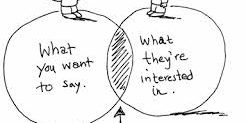Two months ago I began researching touchpoints (TPs) within the high-tech industry. In an earlier blog I outlined what a TP is and the reasons they are so important. In this blog I will discuss some of the most important findings, providing insight into the responses of participants and hopefully on the general theme of TPs.
Through asking people within the high-tech industry which forms of interaction and communication they valued most or were most important to them, we were able to gain an understanding of what kinds of TP interaction should be used and the best time to use them.
Value and relevance

The major theme that emerged from research is that each and every interaction must be relevant and be able to provide value for the customer. But what is value? Well, it is the idea that an interaction between customer and organisation has some benefit to both parties.
Let us look at this in terms of a quarterly newsletter. The recipient is hoping to gain information about various things: market news, product updates or developments, any new technology, activities of the organisation, upcoming events and so on. The organisation is maintaining the relationship they have with this person, offering information they hope will be useful in some way to the recipient; and which they hope will keep them at the forefront of their thoughts for when they next need something that the organisation offers. This is the idea of using TPs that offer value to customers, of maintaining a relationship.
Respondents felt that any TP that did not offer useful or valuable content wasn’t worth their time, and the TP then became viewed in a negative light. This impacted other TPs from the same source, tainting customer perceptions of the company as a whole. What should be taken from this is that relevance and real opportunities for customers to gain something from interaction is key. In an environment where every interaction counts, this is something to take note of.
The importance of timing

In a similar vein, the timing of TPs was something that was extremely important to all respondents. If interaction occurred at the wrong moment in time, this more often than not negatively impacted the perception of that TP. If interaction continued to take place at the wrong times, customers ceased to engage with TPs.
The same was true for how often TPs were experienced. Big gaps of time between exposures to TPs meant people had forgotten the previous interaction. This led to a reduced impact of TPs. TPs that came too often or too soon led to people becoming annoyed. These TPs were then viewed in a bad light, negatively affecting perceptions of that company.
How can I find out what is valuable and use my TPs correctly?
What is valuable to your target audience will depend highly upon their needs and desires. No two markets will be the same. Being able to create true value for both yourself and your customers begins with having a basic idea of the kinds of TPs to use, when to use them and how often.
Findings from this research have highlighted some of the most commonly desired forms of interaction. Amongst them were both digital and physical TPs. The research also sought out information regarding the right time period between interaction and how often people enjoyed this interaction.
We will be delivering our key findings at an event in September. You can register to attend the event for free and/or to receive the key learnings after the event here.







